| Stephanorhinus kirchbergensis Temporal range: | |
|---|---|
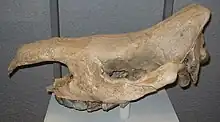 | |
| Mostly complete skull from Germany | |
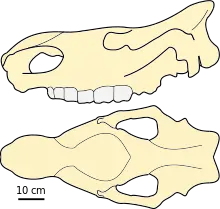 | |
| Diagram of skull from Russia | |
| Scientific classification | |
| Domain: | Eukaryota |
| Kingdom: | Animalia |
| Phylum: | Chordata |
| Class: | Mammalia |
| Order: | Perissodactyla |
| Family: | Rhinocerotidae |
| Genus: | †Stephanorhinus |
| Species: | †S. kirchbergensis |
| Binomial name | |
| †Stephanorhinus kirchbergensis (Jäger, 1839) | |
| Synonyms | |
|
List
| |
Stephanorhinus kirchbergensis, also known as Merck's rhinoceros or the forest rhinoceros, is an extinct species of rhinoceros belonging to the genus Stephanorhinus from the Middle to Late Pleistocene of Eurasia. Its range spanned from western Europe to eastern Asia. Among the last members of the genus, it co-existed alongside Stephanorhinus hemitoechus (the narrow-nosed or steppe rhinoceros) in the western part of its range.
Etymology and taxonomy
The first part of the genus name is derived from that of King Stephen I of Hungary, and the second part from 'rhinos' (ρινος, meaning "nose"), as with Dicerorhinus. The species name was given by Georg Friedrich von Jäger in 1839 for Kirchberg an der Jagst in Baden-Württemberg, Germany where the type specimens had been found.[1] It is often known in English (and equivalents in other languages) as Merck's rhinoceros after Carl Heinrich Merck, who gave the initial name to the species in 1784 as Rhinoceros incisivus, that is now considered a nomen oblitum, and who after a widely used junior synonym of the species, Rhinoceros merckii (historically several alternate spellings) was named by Johann Jakob Kaup in 1841.[2]
Description
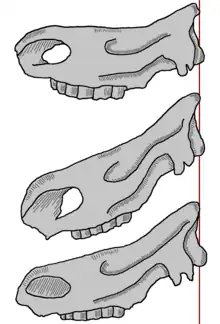
Merck's rhinoceros was a large rhinoceros, with a particularly large specimen from Poland reaching an estimated height at the withers of 1.82 metres (6.0 ft).[3] The bones of the skeleton are robust and massive. The skull of Merck's rhinoceros is elongated, with the septum nasalis ossified only towards its anterior (front) end. The mandibular symphysis is relatively long and the mandible has a horizontal high, thick branch.[4]
Dental anatomy
The enamel of the teeth is very thick, and often bright coloured and smooth, with very thin or absent coronal cement. The buccal (cheek-facing) sides of the teeth often have sub-vertical bluish lines. Tooth dimensions are highly variable in comparison to other Stephanorhinus species. The upper teeth, especially the molars, are much higher towards the buccal side than to the lingual (towards the tongue) side. The ectolophs of the first and second upper molars have shallower folds, especially the fold between the paracone and mesostyle, than those of S. hemitoechus, resulting in a less pronounced undulation. In comparison to other species of Stephanorhinus, the premolars of S. kirchbergensis are mesially (towards the front of the tooth) broad and relatively lingually short. The upper premolar ectoloph folds are shallow, and have narrow anterior valleys. The ectoloph curves strongly mesially and often distally (towards the hind portion of the tooth) towards the inside of the tooth. In both upper molars and premolars, the metalophs and the protolophs are distinctly bulbous. The lower premolars and molars are similar and hard to distinguish.[4]
Origin
The earliest definitive records are from Choukoutien Locality 13, in Fangshan District near Beijing at around the Early-Middle Pleistocene transition.[5] Stephanorhinus yunchuchenensis from Shanxi, China, likely represents a junior synonym of S. kirchbergensis, its precise age is uncertain, but it has been suggested to date to the late Early Pleistocene.[6] S. kirchbergensis appears in Europe during the early Middle Pleistocene between 0.7 and 0.6 million years ago, existing alongside the already present S. hundsheimensis.[7] Mitochondrial and nuclear genomes obtained from a permafrost specimen[8][9] and a dental proteome[10] suggest that it is more closely related to the woolly rhinoceros than the Sumatran rhinoceros. A 2023 morphological study suggested its closest relative was the narrow-nosed rhinoceros (S. hemitoechus).[11]
Relationships among Late Pleistocene and modern rhinoceros genera, based on nuclear DNA, after Liu et al, 2021:[9]
| |||||||||||||||||||||||||||||||||||||||||||
Bayesian morphological phylogeny, after (Pandolfi, 2023) Note: This excludes living African rhinoceros species.[11]
| |||||||||||||||||||||||||||||||||||||||||||||||||||||||||||||||||||||||||||||||||||||||||||||||||||||||||||||||||||||||||||||||||||||||||||||||||||||||||||||||||||||||||||||||||||||||||||
Range
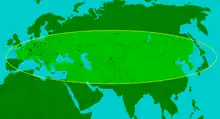
Its range spans from Europe to East Asia, but appears to be absent from the Iberian Peninsula.[12][13] It was predominantly present in Europe during interglacial periods where it formed part of the Palaeoloxodon antiquus assemblage, where it occurred alongside the straight-tusked elephant (Palaeoloxodon antquus) the narrow-nosed rhinoceros (Stephanorhinus hemitoechus), and the hippopotamus (Hippopotamus amphibius).[14] It is presumed to have had a preference for closed forest and woodland habitats, as opposed the to open grassland habitats favoured by S. hemitoechus.[14] Its range extended into the Arctic Circle, with a 70–48,000 year old skull known from arctic Yakutia in the Chondon River valley[8] and a late Middle Pleistocene aged lower jaw from the Yana River valley.[15] Teeth are known from caves in Primorsky Krai , suggested to date between 50,000 and 25,000 years ago based on dates of other bones found in the deposit, which are the easternmost known records,[16] along with a record from the Middle Pleistocene of western Japan.[17] A tooth of S. cf. kirchbergensis of an unknown age is known from the Lut Desert in eastern Iran.[18] It is fairly common throughout the Pleistocene in North China,[19] but is a rarer component of South Chinese assemblages,[20] being known from around 30 localities in the region.[5] Antoine (2012) states that D. choukoutienensis, D. lantianensis, and D. yunchuchenensis are local names for the taxon, without elaboration.[19] Its range was strongly controlled by glacial cycles, with the species experiencing repeated cycles of expansion and contraction as the ice sheets advanced, this accounts for the relative rarity of its remains in comparison to the woolly rhinoceros.[12] The species' range underwent significant reduction during the Last Glacial Period, with the youngest records from Italy being in Marine isotope stage (MIS) 4 and 3.[21] Radiocarbon dated remains from the Altai date to around 40,000 years ago.[22] The youngest reliable records in China are from the Rhino Cave in Hubei, which is early Late Pleistocene in age.[20] Though less definitive remains are known from near Harbin in Heilongjiang, which are thought to be 20 kya in age.[5] Records from Migong Cave just south of the Yangtze River in the Three Gorges area are suggested to date to MIS 2 (29,000-14,000 years ago).[23]
Diet
Merck's rhinoceros has been interpreted as a browser or a mixed feeder, consuming both browse such as branches and leaves of trees and shrubs, as well as low-lying vegetation. Its diet appears to have varied according to local conditions.[24][25][7] Analysis of plant material embedded within teeth from the Neumark-Nord locality in Germany found remains of Populus (poplar or aspen) Quercus (oak), Crataegus (hawthorn), Pyracantha, Urtica (nettles) and Nymphaea (water lilies) as well as indeterminate remains of Betulaceae, Rosaceae, and Poaceae (grass).[26] Preserved plant remains found with the teeth on the arctic Chondon skull included twigs of Salix (willow), Betula (birch) and abundant Larix (larch) alongside fragments of Ericaceae (heather); sedges were notably absent.[8] A specimen from Eemian aged deposits in Gorzów Wielkopolski in Poland had twigs of Corylus (hazel), Carpinus (hornbeam), and Viscum (mistletoe), alongside fruit scales of birch, with hazel and birch dominating amongst the pollen.[24] The pollen from a specimen found at Spinadesco in Italy was dominated (~50%) by trees, particularly Alnus (alder) and Fagus (beech), with Hippophae rhamnoides (sea buckthorn), dominating amongst the shrubs, with around 30% of the total contribution being from a variety of herbaceous plants.[27]
Human exploitation

Cut marks are known on bones of S. kirchbergensis from the Guado San Nicola site in central Italy, which dates to the late Middle Pleistocene, around 400-345,000 years ago.[28] Remains of S. kirchbergensis with cut marks have also been reported from the Medzhibozh locality in western Ukraine, dating to MIS 11, around 425-375,000 years ago.[29] At the Taubach travertine site in Thuringia, Germany, which dates to the Eemian (approximately 130,000-115,000 years ago) abundant remains of Merck's rhinoceros with cut marks are known. The vast majority of remains were of young subadults, alongside a much smaller number of adults. It has been suggested that the rhinoceroses were killed and butchered on site by Neanderthals.[30]
Gallery
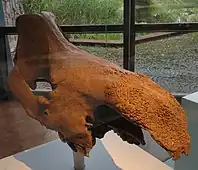 Partial skull in Stuttgart
Partial skull in Stuttgart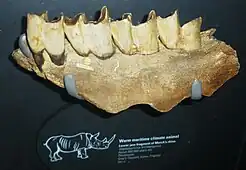 300,000 year old dentary fragment from the United Kingdom in the NHM, London
300,000 year old dentary fragment from the United Kingdom in the NHM, London Remains of Merck's rhinoceros from Germany
Remains of Merck's rhinoceros from Germany View of the top of the snout of a S. kirchbergensis skull, showing the rugose texture of the horn attachment area
View of the top of the snout of a S. kirchbergensis skull, showing the rugose texture of the horn attachment area
References
- ↑ Georg Friedrich Jäger: Über die fossilen Säugetiere welche in Württemberg in verschiedenen Formationen aufgefunden worden sind, nebst geognostischen Bemerkungen über diese Formationen. C. Erhard Verlag, Stuttgart, 1835–39
- ↑ Johann Jakob Kaup: Akten der Urwelt oder Osteologie der urweltlichen Säugethiere und Amphibien. Darmstadt, Verlag des Herausgebers, 1841
- ↑ Sobczyk, Artur; Borówka, Ryszard K.; Badura, Janusz; Stachowicz‐Rybka, Renata; Tomkowiak, Julita; Hrynowiecka, Anna; Sławińska, Joanna; Tomczak, Michał; Pitura, Mateusz; Lamentowicz, Mariusz; Kołaczek, Piotr (May 2020). "Geology, stratigraphy and palaeoenvironmental evolution of the Stephanorhinus kirchbergensis ‐bearing Quaternary palaeolake(s) of Gorzów Wielkopolski (NW Poland, Central Europe)". Journal of Quaternary Science. 35 (4): 539–558. doi:10.1002/jqs.3198. hdl:10261/237944. ISSN 0267-8179. S2CID 216264117.
- 1 2 Selected records of Stephanorhinus kirchbergensis (Jäger, 1839 (Mammalia, Rhinocerotidae) in Italy Emmanuel M.E. BILLIA & Carmelo PETRONIO Bollettino della Società Paleontologica Italiana, 48 (1), 2009, xx-xx. Modena
- 1 2 3 Tong, Hao-wen (November 2012). "Evolution of the non-Coelodonta dicerorhine lineage in China". Comptes Rendus Palevol. 11 (8): 555–562. doi:10.1016/j.crpv.2012.06.002.
- ↑ Pandolfi, Luca (December 2022). "A critical overview on Early Pleistocene Eurasian Stephanorhinus (Mammalia, Rhinocerotidae): Implications for taxonomy and paleobiogeography". Quaternary International: S1040618222003780. doi:10.1016/j.quaint.2022.11.008.
- 1 2 van Asperen, Eline N.; Kahlke, Ralf-Dietrich (January 2015). "Dietary variation and overlap in Central and Northwest European Stephanorhinus kirchbergensis and S. hemitoechus (Rhinocerotidae, Mammalia) influenced by habitat diversity" (PDF). Quaternary Science Reviews. 107: 47–61. doi:10.1016/j.quascirev.2014.10.001. S2CID 83801422.
- 1 2 3 Kirillova, Irina V.; Chernova, Olga F.; van der Made, Jan; Kukarskih, Vladimir V.; Shapiro, Beth; van der Plicht, Johannes; Shidlovskiy, Fedor K.; Heintzman, Peter D.; van Kolfschoten, Thijs; Zanina, Oksana G. (November 2017). "Discovery of the skull of Stephanorhinus kirchbergensis (Jäger, 1839) above the Arctic Circle". Quaternary Research. 88 (3): 537–550. Bibcode:2017QuRes..88..537K. doi:10.1017/qua.2017.53. ISSN 0033-5894. S2CID 45478220.
- 1 2 Liu, Shanlin; Westbury, Michael V.; Dussex, Nicolas; Mitchell, Kieren J.; Sinding, Mikkel-Holger S.; Heintzman, Peter D.; Duchêne, David A.; Kapp, Joshua D.; von Seth, Johanna; Heiniger, Holly; Sánchez-Barreiro, Fátima (16 September 2021). "Ancient and modern genomes unravel the evolutionary history of the rhinoceros family". Cell. 184 (19): 4874–4885.e16. doi:10.1016/j.cell.2021.07.032. hdl:10230/48693. PMID 34433011. S2CID 237273079.
- ↑ Cappellini, Enrico; Welker, Frido; Pandolfi, Luca; Ramos-Madrigal, Jazmín; Samodova, Diana; Rüther, Patrick L.; Fotakis, Anna K.; Lyon, David; Moreno-Mayar, J. Víctor; Bukhsianidze, Maia; et al. (October 2019). "Early Pleistocene enamel proteome from Dmanisi resolves Stephanorhinus phylogeny". Nature. 574 (7776): 103–107. Bibcode:2019Natur.574..103C. doi:10.1038/s41586-019-1555-y. ISSN 0028-0836. PMC 6894936. PMID 31511700.
- 1 2 Pandolfi, Luca (2023-01-19). "Reassessing the phylogeny of Quaternary Eurasian Rhinocerotidae". Journal of Quaternary Science: jqs.3496. doi:10.1002/jqs.3496. hdl:11563/163194. ISSN 0267-8179.
- 1 2 Billa, E.M.E. 2011a. Occurrences of Stephanorhinus kirchbergensis (Jäger, 1839) (Mammalia, Rhinocerotidae) in Eurasia - An account. Acta Palaeontologica Romaniae 7: 17-40
- ↑ Billia, E.M.E., Zervanová, J., 2015. New Stephanorhinus kirchbergensis(Mammalia, Rhinocerotidae) records in Eurasia. Addenda to a previous work. Gortania.Geologia, Paleontologia, Paletnologia36, 55–68.
- 1 2 Pushkina, Diana (July 2007). "The Pleistocene easternmost distribution in Eurasia of the species associated with the Eemian Palaeoloxodon antiquus assemblage". Mammal Review. 37 (3): 224–245. doi:10.1111/j.1365-2907.2007.00109.x. ISSN 0305-1838.
- ↑ Shpansky, A. V.; Boeskorov, G. G. (July 2018). "Northernmost Record of the Merck's Rhinoceros Stephanorhinus kirchbergensis (Jäger) and Taxonomic Status of Coelodonta jacuticus Russanov (Mammalia, Rhinocerotidae)". Paleontological Journal. 52 (4): 445–462. doi:10.1134/S003103011804010X. ISSN 0031-0301. S2CID 91447285.
- ↑ Kosintsev, P. A.; Zykov, S. V.; Tiunov, M. P.; Shpansky, A. V.; Gasilin, V. V.; Gimranov, D. O.; Devjashin, M. M. (March 2020). "The First Find of Merck's Rhinoceros (Mammalia, Perissodactyla, Rhinocerotidae, Stephanorhinus kirchbergensis Jäger, 1839) Remains in the Russian Far East". Doklady Biological Sciences. 491 (1): 47–49. doi:10.1134/S0012496620010032. ISSN 0012-4966. PMID 32483707. S2CID 219156923.
- ↑ Handa, Naoto; Pandolfi, Luca (July 2016). "Reassessment of the Middle Pleistocene Japanese Rhinoceroses (Mammalia, Rhinocerotidae) and Paleobiogeographic Implications". Paleontological Research. 20 (3): 247–260. doi:10.2517/2015PR034. ISSN 1342-8144.
- ↑ Hashemi, N; Ashouri, A; Aliabadian, M; M. Gharaie, M; Sánchez Marco, A; Louys, J (2016). "First report of Quaternary mammals from the Qalehjough area, Lut Desert, Eastern Iran". Palaeontologia Electronica. doi:10.26879/539. ISSN 1094-8074.
- 1 2 Antoine, Pierre-Olivier (March 2012). "Pleistocene and Holocene rhinocerotids (Mammalia, Perissodactyla) from the Indochinese Peninsula". Comptes Rendus Palevol. 11 (2–3): 159–168. doi:10.1016/j.crpv.2011.03.002.
- 1 2 Tong, HaoWen; Wu, XianZhu (April 2010). "Stephanorhinus kirchbergensis (Rhinocerotidae, Mammalia) from the Rhino Cave in Shennongjia, Hubei". Chinese Science Bulletin. 55 (12): 1157–1168. Bibcode:2010ChSBu..55.1157T. doi:10.1007/s11434-010-0050-5. ISSN 1001-6538. S2CID 67828905.
- ↑ Lacombat, Frédéric (2006). "Pleistocene Rhinoceroses in Mediterranean Europe and in Massif Central (France)". CFS Courier Forschungsinstitut Senckenberg.
- ↑ Кириллова, И. В.; Вершинина, А. О.; Зазовская, Э. П.; Занина, О. Г.; Катлер, С.; Косинцев, П. А.; Лаптева, Е. Г.; Чернова, О. Ф.; Шапиро, Б. (2021). "К вопросу о времени и среде обитания Stephanorhinus kirchbergensis Jäger 1839 (Mammalia, Rhinoceratidae) на Алтае и северо-востоке России" [To the question of time and environment of Stephanorhinus kirchbergensis Jäger 1839 (Mammalia, Rhinocerotidae) in Altai and North-East of Russia]. Зоологический Журнал (in Russian). 100 (5): 558–572. doi:10.31857/S0044513421050068. ISSN 0044-5134. S2CID 234970639.
- ↑ Pang, Libo; Chen, Shaokun; Huang, Wanbo; Wu, Yan; Wei, Guangbiao (April 2017). "Paleoenvironmental and chronological analysis of the mammalian fauna from Migong Cave in the Three Gorges Area, China". Quaternary International. 434: 25–31. doi:10.1016/j.quaint.2014.11.039.
- 1 2 Stefaniak, Krzysztof; Stachowicz-Rybka, Renata; Borówka, Ryszard K.; Hrynowiecka, Anna; Sobczyk, Artur; Moskal-del Hoyo, Magdalena; Kotowski, Adam; Nowakowski, Dariusz; Krajcarz, Maciej T.; Billia, Emmanuel M.E.; Persico, Davide (September 2020). "Browsers, grazers or mix-feeders? Study of the diet of extinct Pleistocene Eurasian forest rhinoceros Stephanorhinus kirchbergensis (Jäger, 1839) and woolly rhinoceros Coelodonta antiquitatis (Blumenbach, 1799)". Quaternary International. 605–606: 192–212. doi:10.1016/j.quaint.2020.08.039. hdl:10261/255910. S2CID 224984977.
- ↑ Pandolfi, Luca; Bartolini-Lucenti, Saverio; Cirilli, Omar; Bukhsianidze, Maia; Lordkipanidze, David; Rook, Lorenzo (July 2021). "Paleoecology, biochronology, and paleobiogeography of Eurasian Rhinocerotidae during the Early Pleistocene: The contribution of the fossil material from Dmanisi (Georgia, Southern Caucasus)". Journal of Human Evolution. 156: 103013. doi:10.1016/j.jhevol.2021.103013.
- ↑ Jan van der Made und René Grube: The rhinoceroses from Neumark-Nord and their nutrition. In: Harald Meller (Hrsg.): Elefantenreich – Eine Fossilwelt in Europa. Halle/Saale 2010, S. 382–394
- ↑ Burkanova, Elena M.; Billia, Emmanuel M.E.; Persico, Davide (July 2020). "Stephanorhinus kirchbergensis (Jäger, 1839) (Mammalia, Rhinocerotidae) from the Po valley (Lombardia, Northern Italy): possible diet/nutrition and living conditions". Quaternary International. 554: 164–169. doi:10.1016/j.quaint.2020.07.031. ISSN 1040-6182. S2CID 225542965.
- ↑ Berruti, Gabriele Luigi Francesco; Arzarello, Marta; Ceresa, Allison; Muttillo, Brunella; Peretto, Carlo (December 2020). "Use-Wear Analysis of the Lithic Industry of the Lower Palaeolithic Site of Guado San Nicola (Isernia, Central Italy)". Journal of Paleolithic Archaeology. 3 (4): 794–815. doi:10.1007/s41982-020-00056-3. ISSN 2520-8217.
- ↑ Stepanchuk, V.N.; Moigne, A.-M. (July 2016). "MIS 11-locality of Medzhibozh, Ukraine: Archaeological and paleozoological evidence". Quaternary International. 409: 241–254. doi:10.1016/j.quaint.2015.09.050.
- ↑ Bratlund, B. 1999. Taubach revisited. Jahrbuch des Römisch-Germanischen Zentralmuseums Mainz 46: 61-174.